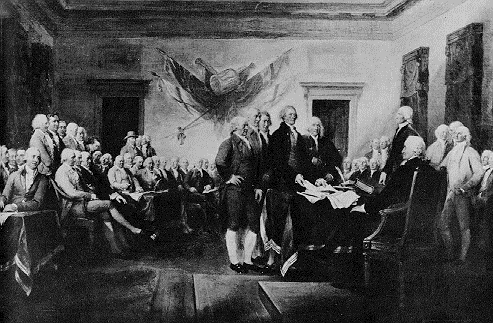 The signing of the Declaration of Independence
The signing of the Declaration of IndependenceFebruary 8: The Revolution and Constitutional Experimentation
 The signing of the Declaration of Independence
The signing of the Declaration of Independence
| In Tuesday's class, we looked at the breakdown of the British/colonial relationship, caused primarily by two factors: the altered international climate following 1763; and the British decision to reassert their colonial power, beginning with the Stamp Act and continuing with the Declaratory Act. The key question--and the correct answer is unclear--is when did the colonists begin to think of themselves as a unified entity--with the Albany Plan? With the Continental Congress? With the Declaration of Independence? |
READING:
secondary:
Wood, Creation of the American Republic (Sourcebook) |
Rakove, Original Meanings, pp. 23-56; read pp. 46-56 closely. |
| The secondary reading for today's class looks at two of the most influential books published on this period. Wood's book, although a quarter-century old, still provides the most complete coverage of constitutional issues and debates at the state level during the Revolution. In general, he sees the Revolution decaying from a democratic high point, as seen especially by the 1776 PA Constitution, to a more conservative period, embodied by the MA Constitution of 1780. We have a clip of it in the sourcebook. The two important things to know: 1.) Why was the upper house kept in most state constitutions? 2.) Wood's point on the link between ideological and constitutional debates in PA. |
Original Meanings, meanwhile, is the rare work of history written in part to influence contemporary events--in this case, the debate over original intent, a favorite cause of contemporary conservatives--while nonetheless providing remarkable research and writing, as witnessed by its having won the Pulitzer Prize. A question to consider: would there have been a Constitution without the role of James Madison? |
documents:
Read the Declaration and the Articles closely; both are very short. For those of you have the PA Constitution, read "A Declaration of Rights" and "A Plan or Frame of Government," sections 1-15. For those of you who have the MA Constitution, read Chapter I, only. The key with both of the constitutions is simply to get the gist of the basic ideas behind the constitutions; I don't care if you know the specifics.
STUDY QUESTIONS:
| 1.) What do you see as the most important difference between the Massachusetts and Pennsylvania constitutions? |
| 2.) Should historians view the Articles of Confederation a "constitution" for a unified country? |
| 3.) Did a "counterrevolution" in consitutional thought occur in the 1780s, as Wood claims? |